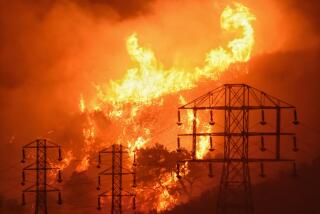Keying Rates to Usage Level Gains Steam
- Share via
SACRAMENTO — Under a plan gaining momentum in the state Capitol, as many as half of Southern California Edison customers would be hit with bigger bills unless they make significant cuts in their electricity use.
The rate increase proposal, which was debated into Tuesday evening by a Senate committee, would target residential consumers who exceed their “baseline” power allowance by more than 30%.
Energy scholars and some lawmakers called the idea a fair approach built on the logic of the incentive-based rate system now in place in California.
“This is not a proposal that socks everybody in the nose,” said Bill Marcus, an energy consultant. “This is a proposal where the basic level of usage--plus a little more--is exempted from any increases.”
But lawmakers of both parties were clearly anxious about the potential impact on consumers and unhappy about the prospect of defending the rate hike, the amount of which remains undetermined.
“When you are participating in representative government, people are going to walk into your office and say, ‘Is my bill going to go up?’ ” said state Sen. Kevin Murray (D-Los Angeles). At this point, Murray said, “it’s not something we can rationally explain to our constituents.”
Southland ratepayers could avoid an increase, another legislator said, if Gov. Gray Davis’ team of negotiators can obtain contracts for long-term power at reasonable rates.
The baseline system, which calculates a household’s minimum allowance based on climate and other factors, is designed to equalize the way energy users are charged.
A customer’s baseline electricity allowance varies by region, with the state divided into territories drawn according to climate. A resident in Malibu has a much lower baseline than one in Palm Springs, for example, because temperatures are much milder on the coast.
Baseline allocations--set by the California Public Utilities Commission--are adjusted seasonally, and a household’s allowance can increase if residents rely on electricity, rather than natural gas, for heat, or if any special medical equipment is used in the home.
The amount of power consumed up to a household’s baseline is charged at one fixed rate, while anything consumed over that minimum costs more.
Most customers exceed their baseline, which is set between 50% and 60% of the average demand in their area. In Southern California Edison’s service area, about two of three customers routinely exceed their allowance, a spokesman said.
“The baseline is considered sort of a subsistence level of usage,” said Steve Hansen, a spokesman for Edison. Because electricity over that level is more expensive, “there’s an incentive to conserve.”
The rate increase proposal would build on that incentive approach, essentially adding a new, third tier of charges. Under the proposal, a rate hike would be tacked on for customers who exceed 130% of their baseline usage.
State officials could not estimate how many customers would be affected statewide. But Hansen said about half of Edison’s customers now use 130% or more of their baseline allowance.
State Sen. Jim Battin (R-La Quinta), who was the most critical of the proposal at Tuesday’s hearing, said the baselines set for his region are “a fantasy.”
“There is a misconception that the Palm Springs area is full of the wealthy. We have a lot of them,” Battin said. But, he added, “There are a lot of people who cannot afford it.”
Other legislators did not seem particularly sympathetic. Assemblyman Fred Keeley (D-Boulder Creek), author of the bill that includes the rate-hike proposal, said Battin’s district enjoys a baseline that is about 300% higher than other areas.
“You’re saying it’s impossible to live within that in your area?” asked state Sen. Byron Sher (D-Stanford), sounding incredulous.
Energy scholars, meanwhile, generally called the proposal a fair approach. Robert Michaels, an energy expert at Cal State Fullerton, noted that a group of economists last week said a rate increase was essential to help solve the state’s energy woes.
“If one of the goals is to protect smaller consumers and encourage conservation, then this is a step--perhaps not the right step, or the only step--in that direction,” said Michaels, a professor of economics.
(BEGIN TEXT OF INFOBOX / INFOGRAPHIC)
Baseline Charges
A customer’s baseline electricity allowance varies by region, with the state divided into territories drawn according to climate. Baseline allocations--set by the California Public Utilities Commission--are adjusted seasonally. A how it works:
*
Baseline: The amount of power a household consumes, up to the baseline, is charged at one fixed rate. The baseline is set at 50% to 60% of average residential usage.
*
Over baseline: Anything consumed over that minimum level costs more. Most customers exceed their baseline.
*
Proposal: The rate increase being considered by the Legislature would build on the baseline system, adding a third tier of charges. Under the proposal, a rate increase would be tacked on for customers who exceed 130% of their baseline usage.
Sources: Southern California Edison, Pacific Gas & Electric
More to Read
Get the L.A. Times Politics newsletter
Deeply reported insights into legislation, politics and policy from Sacramento, Washington and beyond. In your inbox three times per week.
You may occasionally receive promotional content from the Los Angeles Times.










